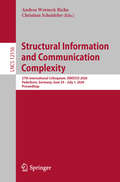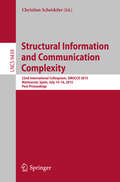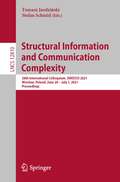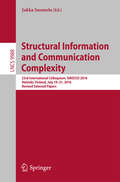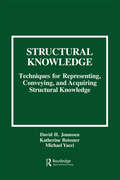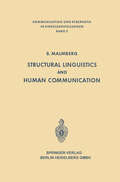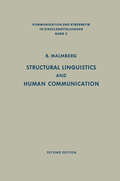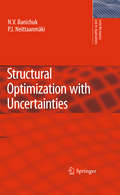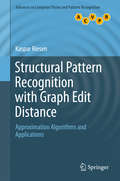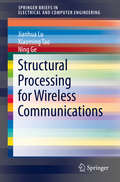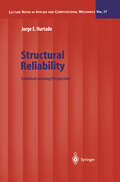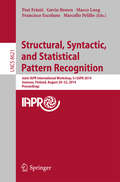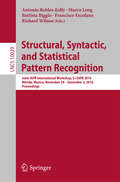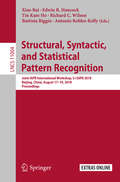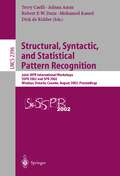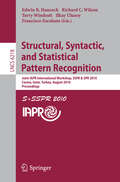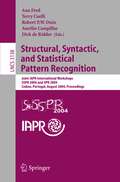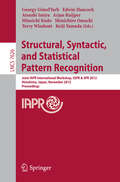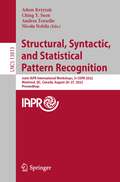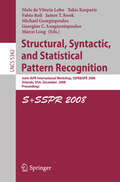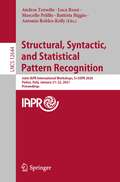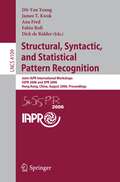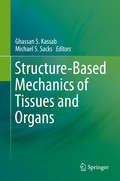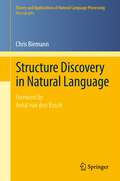- Table View
- List View
Structural Information and Communication Complexity: 27th International Colloquium, SIROCCO 2020, Paderborn, Germany, June 29–July 1, 2020, Proceedings (Lecture Notes in Computer Science #12156)
by Andrea Werneck Richa Christian ScheidelerThis book constitutes the refereed conference proceedings of the 27th International Colloquium on Structural Information and Communication Complexity, SIROCCO 2020, held in Paderborn, Germany, in June 2020.* The 19 full papers and 2 invited papers presented in this book were carefully reviewed and selected from 41 submissions. They are divided into seven sections, i.e. invited papers; mobile robots; dynamic graphs; network communication; multi-agent systems; communication complexity; and game theory. * The conference was held virtually due to the COVID-19 pandemic.
Structural Information and Communication Complexity: 22nd International Colloquium, SIROCCO 2015, Montserrat, Spain, July 14-16, 2015. Post-Proceedings (Lecture Notes in Computer Science #9439)
by Christian ScheidelerThis book constitutes the thoroughly refereed post-conference proceedings of the 22nd International Colloquium on Structural Information and Communication Complexity, SIROCCO 2015, held in Montserrat, Spain, in July 2015. The 30 full papers presented together with 2 invited papers were carefully reviewed and selected from 78 submissions. The papers focus on the study of the interplay between communication and knowledge in multi-processor systems from both the qualitative and quantitative viewpoints.
Structural Information and Communication Complexity: 28th International Colloquium, SIROCCO 2021, Wrocław, Poland, June 28 – July 1, 2021, Proceedings (Lecture Notes in Computer Science #12810)
by Stefan Schmid Tomasz JurdzińskiThis book constitutes the refereed conference proceedings of the 28th International Colloquium on Structural Information and Communication Complexity, SIROCCO 2021, held in Wrocław, Poland, in June 2021. Due to COVID-19, the conference will be held online. The 20 full papers presented in this book were carefully reviewed and selected from 48 submissions. The papers are solicited from all areas of study of local structural knowledge and global communication and computational complexities. Among the typical areas are distributed computing, communication networks, game theory, parallel computing, social networks, mobile computing
Structural Information and Communication Complexity: 23rd International Colloquium, SIROCCO 2016, Helsinki, Finland, July 19-21, 2016, Revised Selected Papers (Lecture Notes in Computer Science #9988)
by Jukka SuomelaThis book constitutes the refereed proceedings of the 23rd International Colloquium on Structural Information and Communication Complexity, SIROCCO 2016, held in Helsinki, Finland in July 2016. The 25 full papers presented were carefully reviewed and selected from 50 submissions. The papers are organized around the following topics: message passing; shared memory; mobile agent; data dissemination and routing.
Structural Knowledge: Techniques for Representing, Conveying, and Acquiring Structural Knowledge
by David H. Jonassen Katherine Beissner Michael YacciThis book introduces the concept of a hypothetical type of knowledge construction -- referred to as structural knowledge -- that goes beyond traditional forms of information recall to provide the bases for knowledge application. Assuming that the validity of the concept is accepted, the volume functions as a handbook for supporting the assessment and use of structural knowledge in learning and instructional settings. It's descriptions are direct and short, and its structure is consistent. Almost all of the chapters describe a technique for representing and assessing structural knowledge acquisition, conveying knowledge structures through direct instruction, or providing learners with strategies that they may use to acquire structural knowledge. These chapters include the following sections in the same sequence: * description of the technique and its theoretical or conceptual rationale * examples and applications * procedures for development and use * effectiveness -- learner interactions and differences, and advantages and disadvantages * references to the literature. The chapters are structured to facilitate access to information as well as to illuminate comparisons and contrasts among the techniques.
Structural Knowledge: Techniques for Representing, Conveying, and Acquiring Structural Knowledge
by David H. Jonassen Katherine Beissner Michael YacciThis book introduces the concept of a hypothetical type of knowledge construction -- referred to as structural knowledge -- that goes beyond traditional forms of information recall to provide the bases for knowledge application. Assuming that the validity of the concept is accepted, the volume functions as a handbook for supporting the assessment and use of structural knowledge in learning and instructional settings. It's descriptions are direct and short, and its structure is consistent. Almost all of the chapters describe a technique for representing and assessing structural knowledge acquisition, conveying knowledge structures through direct instruction, or providing learners with strategies that they may use to acquire structural knowledge. These chapters include the following sections in the same sequence: * description of the technique and its theoretical or conceptual rationale * examples and applications * procedures for development and use * effectiveness -- learner interactions and differences, and advantages and disadvantages * references to the literature. The chapters are structured to facilitate access to information as well as to illuminate comparisons and contrasts among the techniques.
Structural Linguistics and Human Communication: An Introduction into the Mechanism of Language and the Methodology of Linguistics (Communication and Cybernetics #2)
by Bertil MalmbergStructural Linguistics and Human Communication: An Introduction into the Mechanism of Language and the Methodology of Linguistics (Communication and Cybernetics #2)
by Bertil MalmbergThe point of departure of this general survey of modern structural linguistics is the place of language in human relations. Linguistics will consequently be understood as a science of communication. My book is not intended as an elementary handbook. The readers are supposed to be in the first place advanced students of linguistics and phonetics and of neighbouring fields where a real awareness of linguistic methods and problems is essential (such as psychology, phoniatrics, speech therapy, language teaching, communication engineering). The book may, however, be of some value also for the general reader who is interested in language, in language learning, or in communication processes. It might finally serve as an introduction to structural theories and practice for those linguists of traditional orientation who would like to make contact with the new trends in the study of language. It is self-evident that, under such circumstances, any reader will find certain chapters in this book rather complicated, others irritatingly elementary. This is, however, unavoidable in a work whose aim is to cover a vast field of knowledge and to offer the reader a synthesis of what appears at first sight to be widely disparate facts and phenomena. Many of the facts brought together here may, regarded superficially, seem to have few or no mutual connections. They can, nevertheless, be combined into a wide humanistic and scientific unity within which numerous lines of relationship bind together physical and psychic, individual and social phenomena.
Structural Optimization with Uncertainties (Solid Mechanics and Its Applications #162)
by N.V. Banichuk Pekka NeittaanmäkiStructural optimization is currently attracting considerable attention. Interest in - search in optimal design has grown in connection with the rapid development of aeronautical and space technologies, shipbuilding, and design of precision mach- ery. A special ?eld in these investigations is devoted to structural optimization with incomplete information (incomplete data). The importance of these investigations is explained as follows. The conventional theory of optimal structural design - sumes precise knowledge of material parameters, including damage characteristics and loadings applied to the structure. In practice such precise knowledge is seldom available. Thus, it is important to be able to predict the sensitivity of a designed structure to random ?uctuations in the environment and to variations in the material properties. To design reliable structures it is necessary to apply the so-called gu- anteed approach, based on a “worst case scenario” or a more optimistic probabilistic approach, if we have additional statistical data. Problems of optimal design with incomplete information also have consid- able theoretical importance. The introduction and investigations into new types of mathematical problems are interesting in themselves. Note that some ga- theoretical optimization problems arise for which there are no systematic techniques of investigation. This monograph is devoted to the exposition of new ways of formulating and solving problems of structural optimization with incomplete information. We recall some research results concerning the optimum shape and structural properties of bodies subjected to external loadings.
Structural Pattern Recognition with Graph Edit Distance: Approximation Algorithms and Applications (Advances in Computer Vision and Pattern Recognition)
by Kaspar RiesenThis unique text/reference presents a thorough introduction to the field of structural pattern recognition, with a particular focus on graph edit distance (GED). The book also provides a detailed review of a diverse selection of novel methods related to GED, and concludes by suggesting possible avenues for future research. Topics and features: formally introduces the concept of GED, and highlights the basic properties of this graph matching paradigm; describes a reformulation of GED to a quadratic assignment problem; illustrates how the quadratic assignment problem of GED can be reduced to a linear sum assignment problem; reviews strategies for reducing both the overestimation of the true edit distance and the matching time in the approximation framework; examines the improvement demonstrated by the described algorithmic framework with respect to the distance accuracy and the matching time; includes appendices listing the datasets employed for the experimental evaluations discussed in the book.
Structural Processing for Wireless Communications (SpringerBriefs in Electrical and Computer Engineering)
by Jianhua Lu Xiaoming Tao Ning GeThis brief presents an alternative viewpoint on processing technology for wireless communications based on recent research advances. As a lever in emerging processing technology, the structure perspective addresses the complexity and uncertainty issues found in current wireless applications. Likewise, this brief aims at providing a new prospective to the development of communication technology and information science, while stimulating new theories and technologies for wireless systems with ever-increasing complexity. Readers of this brief may range from graduate students to researchers in related fields.
Structural Reliability: Statistical Learning Perspectives (Lecture Notes in Applied and Computational Mechanics #17)
by Jorge Eduardo HurtadoThe last decades have witnessed the development of methods for solving struc tural reliability problems, which emerged from the efforts of numerous re searchers all over the world. For the specific and most common problem of determining the probability of failure of a structural system in which the limit state function g( x) = 0 is only implicitly known, the proposed methods can be grouped into two main categories: • Methods based on the Taylor expansion of the performance function g(x) about the most likely failure point (the design point), which is determined in the solution process. These methods are known as FORM and SORM (First- and Second Order Reliability Methods, respectively). • Monte Carlo methods, which require repeated calls of the numerical (nor mally finite element) solver of the structural model using a random real ization of the basic variable set x each time. In the first category of methods only SORM can be considered of a wide applicability. However, it requires the knowledge of the first and second deriva tives of the performance function, whose calculation in several dimensions either implies a high computational effort when faced with finite difference techniques or special programs when using perturbation techniques, which nevertheless require the use of large matrices in their computations. In or der to simplify this task, use has been proposed of techniques that can be regarded as variants of the Response Surface Method.
Structural, Syntactic, and Statistical Pattern Recognition: Joint IAPR International Workshop, S+SSPR 2014, Joensuu, Finland, August 20-22, 2014, Proceedings (Lecture Notes in Computer Science #8621)
by Pasi Änti Gavin Brown Marco Loog Francisco Escolano Marcello PelilloThis book constitutes the proceedings of the Joint IAPR International Workshop on Structural, Syntactic, and Statistical Pattern Recognition, S+SSPR 2014; comprising the International Workshop on Structural and Syntactic Pattern Recognition, SSPR, and the International Workshop on Statistical Techniques in Pattern Recognition, SPR. The total of 25 full papers and 22 poster papers included in this book were carefully reviewed and selected from 78 submissions. They are organized in topical sections named: graph kernels; clustering; graph edit distance; graph models and embedding; discriminant analysis; combining and selecting; joint session; metrics and dissimilarities; applications; partial supervision; and poster session.
Structural, Syntactic, and Statistical Pattern Recognition: Joint IAPR International Workshop, S+SSPR 2016, Mérida, Mexico, November 29 - December 2, 2016, Proceedings (Lecture Notes in Computer Science #10029)
by Antonio Robles-Kelly, Marco Loog, Battista Biggio, Francisco Escolano and Richard WilsonThis book constitutes the proceedings of the Joint IAPR International Workshop on Structural Syntactic, and Statistical Pattern Recognition, S+SSPR 2016, consisting of the International Workshop on Structural and Syntactic Pattern Recognition SSPR, and the International Workshop on Statistical Techniques in Pattern Recognition, SPR. The 51 full papers presented were carefully reviewed and selected from 68 submissions. They are organized in the following topical sections: dimensionality reduction, manifold learning and embedding methods; dissimilarity representations; graph-theoretic methods; model selection, classification and clustering; semi and fully supervised learning methods; shape analysis; spatio-temporal pattern recognition; structural matching; text and document analysis.
Structural, Syntactic, and Statistical Pattern Recognition: Joint IAPR International Workshop, S+SSPR 2018, Beijing, China, August 17–19, 2018, Proceedings (Lecture Notes in Computer Science #11004)
by Xiao Bai Edwin R. Hancock Tin Kam Ho Richard C. Wilson Battista Biggio Antonio Robles-KellyThis book constitutes the proceedings of the Joint IAPR International Workshop on Structural, Syntactic, and Statistical Pattern Recognition, S+SSPR 2018, held in Beijing, China, in August 2018.The 49 papers presented in this volume were carefully reviewed and selected from 75 submissions. They were organized in topical sections named: classification and clustering; deep learning and neurla networks; dissimilarity representations and Gaussian processes; semi and fully supervised learning methods; spatio-temporal pattern recognition and shape analysis; structural matching; multimedia analysis and understanding; and graph-theoretic methods.
Structural, Syntactic, and Statistical Pattern Recognition: Joint IAPR International Workshops SSPR 2002 and SPR 2002, Windsor, Ontario, Canada, August 6-9, 2002. Proceedings (Lecture Notes in Computer Science #2396)
by Terry Caelli Adnan Amin Robert P. W. Duin Mohamed Kamel Dick De RidderThis volume contains all papers presented at SSPR 2002 and SPR 2002 hosted by the University of Windsor, Windsor, Ontario, Canada, August 6-9, 2002. This was the third time these two workshops were held back-to-back. SSPR was the ninth International Workshop on Structural and Syntactic Pattern Recognition and the SPR was the fourth International Workshop on Statis- cal Techniques in Pattern Recognition. These workshops have traditionally been held in conjunction with ICPR (International Conference on Pattern Recog- tion), and are the major events for technical committees TC2 and TC1, resp- tively, of the International Association of Pattern Recognition (IAPR). The workshops were held in parallel and closely coordinated. This was an attempt to resolve the dilemma of how to deal, in the light of the progressive specialization of pattern recognition, with the need for narrow-focus workshops without further fragmenting the ?eld and introducing yet another conference that would compete for the time and resources of potential participants. A total of 116 papers were received from many countries with the submission and reviewingprocesses beingcarried out separately for each workshop. A total of 45 papers were accepted for oral presentation and 35 for posters. In addition four invited speakers presented informative talks and overviews of their research. They were: Tom Dietterich, Oregon State University, USA Sven Dickinson, the University of Toronto, Canada Edwin Hancock, University of York, UK Anil Jain, Michigan State University, USA SSPR 2002 and SPR 2002 were sponsored by the IAPR and the University of Windsor.
Structural, Syntactic, and Statistical Pattern Recognition: Joint IAPR International Workshop, SSPR & SPR 2010, Cesme, Izmir, Turkey, August 18-20, 2010. Proceedings (Lecture Notes in Computer Science #6218)
by Francisco Escolano Edwin R. Hancock Richard C. Wilson Terry Windeatt Ilkay UlusoyThis volume in the Springer Lecture Notes in Computer Science (LNCS) series contains the papers presented at the S+SSPR 2010 Workshops, which was the seventh occasion that SPR and SSPR workshops have been held jointly. S+SSPR 2010 was organized by TC1 and TC2, Technical Committees of the International Association for Pattern Recognition(IAPR), andheld inCesme, Izmir, whichis a seaside resort on the Aegean coast of Turkey. The conference took place during August 18–20, 2010, only a few days before the 20th International Conference on Pattern Recognition (ICPR) which was held in Istanbul. The aim of the series of workshops is to create an international forum for the presentation of the latest results and exchange of ideas between researchers in the ?elds of statistical and structural pattern recognition. SPR 2010 and SSPR 2010 received a total of 99 paper submissions from many di?erent countries around the world, giving it a truly international perspective, as has been the case for previous S+SSPR workshops. This volume contains 70 accepted papers, 39 for oral and 31 for poster presentation. In addition to par- lel oral sessions for SPR and SSPR, there were two joint oral sessions of interest to both SPR and SSPR communities. Furthermore, to enhance the workshop experience, there were two joint panel sessions on “Structural Learning” and “Clustering,” in which short author presentations were followed by discussion. Another innovation this year was the ?lming of the proceedings by Videol- tures.
Structural, Syntactic, and Statistical Pattern Recognition: Joint IAPR International Workshops, SSPR 2004 and SPR 2004, Lisbon, Portugal, August 18-20, 2004 Proceedings (Lecture Notes in Computer Science #3138)
by Ana Fred Terry Caelli Robert P. W. Duin Aurélio Campilho Dick De RidderStructural, Syntactic, and Statistical Pattern Recognition: Joint IAPR International Workshop, SSPR & SPR 2012, Hiroshima, Japan, November 7-9, 2012, Proceedings (Lecture Notes in Computer Science #7626)
by Georgy Gimel´farb Edwin Hancock Atsushi Imiya Arjan Kuijper Mineichi Kudo Shinichiro Omachi Terry Windeatt Keiji YamadaThis volume constitutes the refereed proceedings of the Joint IAPR International Workshops on Structural and Syntactic Pattern Recognition (SSPR 2012) and Statistical Techniques in Pattern Recognition (SPR 2012), held in Hiroshima, Japan, in November 2012 as a satellite event of the 21st International Conference on Pattern Recognition, ICPR 2012. The 80 revised full papers presented together with 1 invited paper and the Pierre Devijver award lecture were carefully reviewed and selected from more than 120 initial submissions. The papers are organized in topical sections on structural, syntactical, and statistical pattern recognition, graph and tree methods, randomized methods and image analysis, kernel methods in structural and syntactical pattern recognition, applications of structural and syntactical pattern recognition, clustering, learning, kernel methods in statistical pattern recognition, kernel methods in statistical pattern recognition, as well as applications of structural, syntactical, and statistical methods.
Structural, Syntactic, and Statistical Pattern Recognition: Joint IAPR International Workshops, S+SSPR 2022, Montreal, QC, Canada, August 26–27, 2022, Proceedings (Lecture Notes in Computer Science #13813)
by Adam Krzyzak Ching Y. Suen Andrea Torsello Nicola NobileThis book constitutes the proceedings of the Joint IAPR International Workshop on Structural, Syntactic, and Statistical Pattern Recognition, S+SSPR 2022, held in Montreal, QC, Canada, in August 2022.The 30 papers together with 2 invited talks presented in this volume were carefully reviewed and selected from 50 submissions. The workshops presents papers on topics such as deep learning, processing, computer vision, machine learning and pattern recognition and much more.
Structural, Syntactic, and Statistical Pattern Recognition: Joint IAPR International Workshop, SSPR & SPR 2008, Orlando, USA, December 4-6, 2008. Proceedings (Lecture Notes in Computer Science #5342)
by Niels Da Vitoria Lobo Takis Kasparis Michael Georgiopoulos Fabio Roli James Kwok Georgios C. Anagnostopoulos Marco LoogThis volume in the Springer Lecture Notes in Computer Science (LNCS) series contains 98 papers presented at the S+SSPR 2008 workshops. S+SSPR 2008 was the sixth time that the SPR and SSPR workshops organized by Technical Committees, TC1 and TC2, of the International Association for Pattern Rec- nition (IAPR) wereheld as joint workshops. S+SSPR 2008was held in Orlando, Florida, the family entertainment capital of the world, on the beautiful campus of the University of Central Florida, one of the up and coming metropolitan universities in the USA. S+SSPR 2008 was held during December 4–6, 2008 only a few days before the 19th International Conference on Pattern Recog- tion(ICPR2008),whichwasheldin Tampa,onlytwo hoursawayfromOrlando, thus giving the opportunity of both conferences to attendees to enjoy the many attractions o?ered by two neighboring cities in the state of Florida. SPR 2008 and SSPR 2008 received a total of 175 paper submissions from many di?erent countries around the world, thus giving the workshop an int- national clout, as was the case for past workshops. This volume contains 98 accepted papers: 56 for oral presentations and 42 for poster presentations. In addition to parallel oral sessions for SPR and SSPR, there was also one joint oral session with papers of interest to both the SPR and SSPR communities. A recent trend that has emerged in the pattern recognition and machine lea- ing research communities is the study of graph-based methods that integrate statistical andstructural approaches.
Structural, Syntactic, and Statistical Pattern Recognition: Joint IAPR International Workshops, S+SSPR 2020, Padua, Italy, January 21–22, 2021, Proceedings (Lecture Notes in Computer Science #12644)
by Andrea Torsello Luca Rossi Marcello Pelillo Battista Biggio Antonio Robles-KellyThis book constitutes the proceedings of the Joint IAPR International Workshop on Structural, Syntactic, and Statistical Pattern Recognition, S+SSPR 2020, held in Padua, Italy, in January 2021. The 35 papers presented in this volume were carefully reviewed and selected from 81 submissions. The accepted papers cover the major topics of current interest in pattern recognition, including classification and clustering, deep learning, structural matching and graph-theoretic methods, and multimedia analysis and understanding.
Structural, Syntactic, and Statistical Pattern Recognition: Joint IAPR International Workshops, SSPR 2006 and SPR 2006, Hong Kong, China, August 17-19, 2006, Proceedings (Lecture Notes in Computer Science #4109)
by Dit-Yan Yeung James T. Kwok Ana Fred Fabio Roli Dick De RidderThis is the proceedings of the 11th International Workshop on Structural and Syntactic Pattern Recognition, SSPR 2006 and the 6th International Workshop on Statistical Techniques in Pattern Recognition, SPR 2006, held in Hong Kong, August 2006 alongside the Conference on Pattern Recognition, ICPR 2006. 38 revised full papers and 61 revised poster papers are included, together with 4 invited papers covering image analysis, character recognition, bayesian networks, graph-based methods and more.
Structure-Based Mechanics of Tissues and Organs
by Ghassan S. Kassab Michael S. SacksThis book portrays the commonality of tissue micro-structure that dictates physiological function in various organs (microstructure-function relation). Tissue and organ models are used to illustrate physiological functions based on microstructure. Fiber scale properties such as orientation and crimp are described in detail. Structurally-based constitutive models are given throughout the book, not only to avoid ambiguities in material characterization, but also to offer insights into the function, structure, and mechanics of tissue components. A statement of future directions of the field is also given, including how advancements, such as state-of-the-art computational modeling and optical measurements of tissue/cells structures, are taking structure-based modeling to the next level.This book also:Provides a comprehensive view of tissue modeling across multiple systemsBroadens readers’ understanding of state-of-the-art computational modeling and optical measurements of tissue/cells structuresDescribes in detail fiber scale properties such as orientation and crimp
Structure Discovery in Natural Language (Theory and Applications of Natural Language Processing)
by Chris BiemannCurrent language technology is dominated by approaches that either enumerate a large set of rules, or are focused on a large amount of manually labelled data. The creation of both is time-consuming and expensive, which is commonly thought to be the reason why automated natural language understanding has still not made its way into “real-life” applications yet. This book sets an ambitious goal: to shift the development of language processing systems to a much more automated setting than previous works. A new approach is defined: what if computers analysed large samples of language data on their own, identifying structural regularities that perform the necessary abstractions and generalisations in order to better understand language in the process?After defining the framework of Structure Discovery and shedding light on the nature and the graphic structure of natural language data, several procedures are described that do exactly this: let the computer discover structures without supervision in order to boost the performance of language technology applications. Here, multilingual documents are sorted by language, word classes are identified, and semantic ambiguities are discovered and resolved without using a dictionary or other explicit human input. The book concludes with an outlook on the possibilities implied by this paradigm and sets the methods in perspective to human computer interaction.The target audience are academics on all levels (undergraduate and graduate students, lecturers and professors) working in the fields of natural language processing and computational linguistics, as well as natural language engineers who are seeking to improve their systems.
